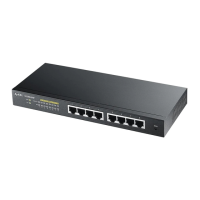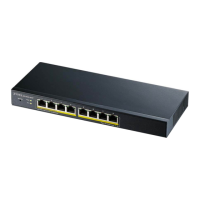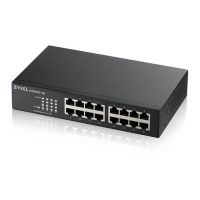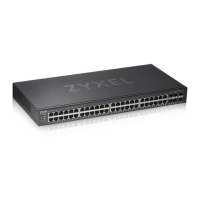GS1350 Series User’s Guide
121
CHAPTER 9
VLAN
9.1 Overview
This chapter shows you how to configure 802.1Q tagged and port-based VLANs. The type of screen you
see here depends on the VLAN Type you selected in the Switch Setup screen.
9.1.1 What You Can Do
• Use the VLAN screen (Section 9.2 on page 123) to view and search all VLAN groups.
• Use the VLAN Detail screen (Section 9.2.1 on page 124) to view detailed port settings and status of the
VLAN group.
• Use the Static VLAN Setup screen (Section 9.4 on page 126) to configure and view 802.1Q VLAN
parameters for the Switch.
• Use the VLAN Port Setup screen (Section 9.5 on page 127) to configure the static VLAN (IEEE 802.1Q)
settings on a port.
• Use the Voice VLAN Setup screen (Section 9.6 on page 128) to set up VLANs that allow you to group
voice traffic with defined priority and enable the Switch port to carry the voice traffic separately from
data traffic to ensure the sound quality does NOT deteriorate.
• Use the MAC Based VLAN Setup screen (Section 9.7 on page 130) to set up VLANs that allow you to
group untagged packets into logical VLANs based on the source MAC address of the packet. This
eliminates the need to reconfigure the Switch when you change ports. The Switch will forward the
packets based on the source MAC address you set up previously.
• Use the Vendor ID Based VLAN Setup screen (Section 9.8 on page 131) to set up VLANs that allow you
to group untagged packets into logical VLANs based on the source MAC address of the packet. You
can specify a mask for the MAC address to create a MAC address filter and enter a weight to set the
VLAN rule’s priority.
• Use the Port-Based VLAN Setup screen (Section 9.9 on page 133) to set up VLANs where the packet
forwarding decision is based on the destination MAC address and its associated port.
9.1.2 What You Need to Know
Read this section to know more about VLAN and how to configure the screens.
IEEE 802.1Q Tagged VLANs
A tagged VLAN uses an explicit tag (VLAN ID) in the MAC header to identify the VLAN membership of a
frame across bridges
– they are not confined to the switch on which they were created. The VLANs can
be created statically by hand. The VLAN ID associates a frame with a specific VLAN and provides the
information that switches need to process the frame across the network. A tagged frame is 4 bytes
longer than an untagged frame and contains 2 bytes of TPID (Tag Protocol Identifier, residing within the
type/length field of the Ethernet frame) and 2 bytes of TCI (Tag Control Information, starts after the
source address field of the Ethernet frame).

